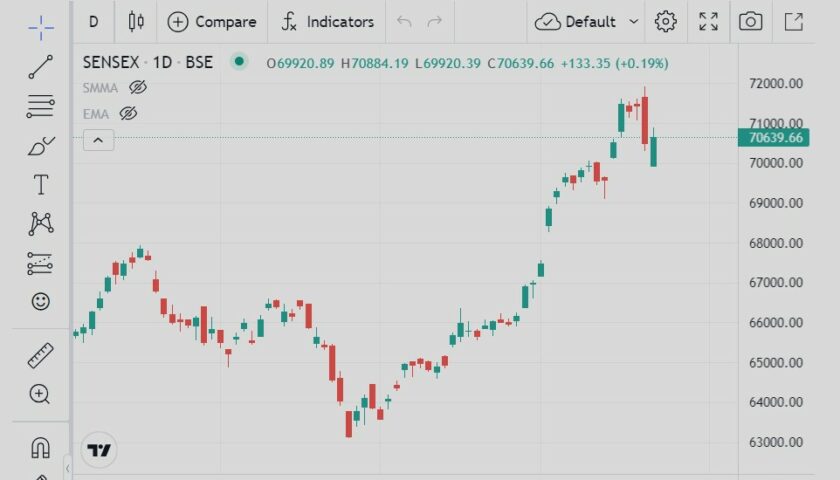
Sensex Market Meltdown: Unveiling the Dominant Forces Behind the 2,000-Point Plunge
Sensex Market Meltdown: Unveiling the Dominant Forces Behind the 2,000-Point Plunge
Sensex plunges by 2,000 points in a span of two days! Explore the five factors contributing to the decline in the stock market
The decline in both Sensex and Nifty is, in part, a result of foreign portfolio investors offloading domestic stocks, as indicated by provisional data from NSE, which reveals a sell-off totaling Rs 1,322.08 crore on Wednesday.
With the BSE Sensex plummeting from an intraday high of 71,910.14 on Wednesday to a low of 69,920.39 on Thursday morning, a substantial drop of 1,989.75 points, it appears that the anticipated Santa rally has concluded. Various factors contribute to this market downturn, with a primary concern being the apprehension over valuations following a recent surge. This is evident in the sharp decline of midcap and smallcap counters, which had previously led the return charts in recent months.

The market’s downturn can also be attributed to several factors, including foreign portfolio investment outflows, weak global indicators, anxieties regarding the escalating Covid cases in India, and fears of potential increases in oil prices due to dollar weakness and Red Sea attacks. These collective factors have effectively put a pause on the recent market upswing, prompting investors to capitalize on profits amid the prevailing uncertainties.
Valuations in the market
Between October 26 and December 15, the Sensex surged by approximately 8,350 points or 13%, displaying relentless upward momentum. Concurrently, the Nifty ascended from a level below 19,000 to around 21,600.
Kenneth Andrade, Founder and Director at Old Bridge Capital Management, expressed concern over the market’s current state. He noted that the market cap-to-GDP ratio has reached levels indicative of potential overvaluation, signaling a need for caution as the market may have priced itself well ahead of the curve.
Andrade highlighted specific areas of concern, particularly excesses in the small and microcap space, prompting caution and an anticipation of volatility, particularly in segments where valuations appear steep. Despite these short-term challenges, he acknowledged an overarching trend favoring India, presenting a higher growth potential compared to peer countries in the region.
Foreign Portfolio Investment (FPI) Outflows
The decline in Sensex and Nifty is partially attributed to the divestment by foreign portfolio investors (FPIs), as indicated by provisional data from NSE, revealing a sale of domestic stocks amounting to Rs 1,322.08 crore on Wednesday. This selling activity was notably observed in anticipation of the Christmas holidays.

It is noteworthy that December has been marked as the most favorable month in terms of FPI inflows, totaling Rs 56,617 crore. Therefore, the profit-taking by FPIs aligns with expectations, considering the positive trend in FPI inflows during the month.
Underwhelming International Market Indicators
The challenges faced by domestic indices are not isolated. During overnight trading, U.S. stocks experienced a sudden mid-afternoon selloff, leading to a significant decline in the Dow Jones Industrial Average by 475.92 points, or 1.27%, closing at 37,082. The S&P500 index also recorded a loss of 70.02 points, or 1.47%, settling at 4,698.35 overnight, while the Nasdaq Composite dropped by 225.28 points, or 1.5%, closing at 14,777.94. Asian markets were similarly grappling with adversity, with Japan’s Nikkei leading the list of losers.
Concerns Regarding Oil Prices
Apprehensions have emerged regarding a potential surge in oil prices driven by geopolitical tensions. Emkay Global, citing the Bloomberg consensus forecast, projects Brent crude to reach $78 per barrel by 2024. Historically, the relationship between crude prices and Indian equities has been asymmetric. Analysts note that crude oil has displayed considerable volatility, particularly in response to heightened supply concerns stemming from attacks in the Red Sea.
The disruptions caused by attacks from Yemen’s Iran-aligned Houthi militants on ships have led to disturbances in maritime trade, prompting companies to reroute vessels. Additionally, the weakening dollar index and the prospect of Federal Reserve rate cuts in 2024 have contributed to the upward trajectory of crude oil prices. Despite these factors, concerns about Chinese demand have somewhat tempered the overall gains in crude oil, as highlighted by Rahul Kalantri, VP Commodities at Mehta Equities this week.
keep tuned in for more updates
Concerns Over Increasing Covid Cases
The escalating number of Covid cases is adding to the market’s apprehensions. On Wednesday, Mansukh Mandaviya, the Union Minister of Health and Family Welfare, announced plans for mock drills to be conducted every three months at both Central and State levels. This decision comes in response to a surge in Covid-19 cases, with 614 new infections reported in the past 24 hours. The rise in cases is attributed to the Covid sub-variant JN.1, initially identified in Kerala.

